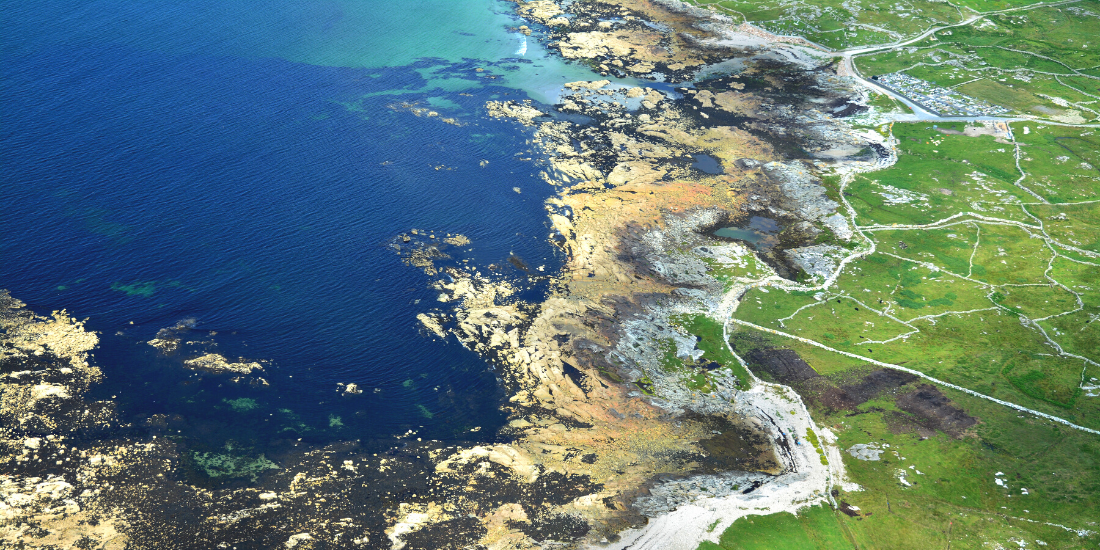Planning a day trip or a vacation to the beautiful Aran Islands? These ruggedly beautiful islands welcome around 200,000 visitors every year, all keen to catch a glimpse of real Ireland, escape from the busyness of the modern world, experience traditional culture, and of course, take in the desolate windswept beauty of this unique location.
The Aran Islands have a powerful spiritual appeal for a diverse range of people. With a solid religious faith present on the islands and holding some of the best Christian and pre-Christian ancient sites, all sorts of people of various religious beliefs and walks of life visit the islands each year.
Due to the area’s Celtic and Christian heritage, the Aran Islands have an unusually high number of ruins and sacred sites. Holy Ireland, known as the Island of Saints and Scholars, has historically centered around Celtic and Christian pilgrimage. It’s said that just by exploring or being in the Aran Islands, you are on a path to connecting with your inner spiritual self to become blessed.

Many visitors to the islands have been divinely healed by attending spiritual ceremonies such as the Summer Solstice. Furthermore, increasing numbers of people are choosing to get married on the Aran Islands, and tourism has increased in recent years as many foreigners are gravitating towards the island’s reputation of rejuvenation and spiritual connectedness.
Interwoven in the history of the Aran Islands, is the tradition of making Aran sweaters. It’s more likely that you’ve heard of the sweater before the islands they originated in. As suggested in the name, Aran sweaters originated in the Aran Islands and contributed to the area’s incredibly rich history.
About the Aran Islands

Just off the coasts of counties Galway and Clare are long, low islands of limestone and rare bleak beauty. Resting on the very edge of Europe, the Aran Islands are rich in the culture, language, and heritage of Ireland.
Unique both in geology and archaeology and in its long tradition of hospitality, the three Aran Islands, Inis Mor, Inis Meain, and Inis Oirr, contain the sites of some of the most ancient remains in Europe. However, each island is distinct and different.
The Aran Islands are a group of three islands in Galway Bay, off the west coast of Ireland. They’re home to some of the oldest archaeological sites in Ireland and have a fascinating history.
Isolated from the mainland until the 20th century, traditional island life continues in many ways as it has for hundreds of years, with most residents making a living through subsistence farming and fishing. The islands are also the home of the world-famous Aran knitwear.
Gaelic is the official language of the Aran Islands and is the first and preferred language of most of the residents. These days everyone speaks English too, but if you try out a couple of phrases you’re sure to get a smile! If you stay overnight, it’s a must to hang out with the locals in one of the local pubs, where you can enjoy a pint or two and listen to traditional live music.
Let’s take a deeper look at each of the three islands in detail.
Inis Mor (Inishmore) Island

Inis Mor is the biggest of the three Aran Islands, with ‘Mor’ meaning ‘big.’ The landscape of the island is unique, with miles of rock walls and limestone that extend out to gigantic cliffs on the western side of the island.
The wave-sculpted coastline, thriving seal colony, ducks, wild swans, and rare birds all complement the buzzing nightlife, local cafés and restaurants, and the ancient sites of Dún Aonghasa (Dun Aengus) and Na Seacht dTeampaíll (The Seven Churches) that this island is famous for.
Inis Mor is the most westerly and the largest of the three islands. It’s only around 9 miles long and less than 2.5 miles wide at its widest point, which makes it easy to travel around the whole island in a day. It’s the most popular with visitors and offers the most amenities such as shops, cafes, and accommodation options.
The island is home to around 1,000 people and there are fewer than 100 vehicles. Most visitors rent bikes to get around, and you can also take a tour in a pony and trap, which is a popular activity with many tourists.
There are also minibus tours available, which can be handy if you’re on a day trip and want to see as much as you can in a short time frame.
Places to Stay on Inis Mor
Here’s some of our top picks of the accommodation on Inis Mor:
- Kilronan Hostel - A cosy budget accommodation option with small shared dorm rooms.
- Aran's Walker's Lodge - A comfortable mid-price option that’s great for solo travelers and serves up a good breakfast.
- Ard Einne House - Good value for money guesthouse with amazing views.
- Ard Mhuiris B&B - A family-run B&B in an excellent location with free ferry transfers.
- Pier House Guesthouse - Great location close to the pier, and with a nice restaurant.
- Aran Islands Hotel - A traditional island hotel with an attached pub that offers regular live music.
- Tigh Fitz - A family-run guesthouse with clean rooms and friendly hosts.
Things to See and Do on Inis Mor
- Kilronan Village - This is the only village on all three of the islands and is also the only place on the island with a supermarket and ATM, so it’s essential to stop here for supplies. It’s also a quaint little village that’s fun to explore with several cafes, gift shops, and traditional Irish pubs where you can meet the locals.
- Dún Aonghasa - A 2,000-year-old Celtic fort on the edge of a massive limestone cliff. This is the most famous tourist attraction on the Aran Islands and is definitely a must-see.
- Seven Churches - Another archaeological site containing the ruins of several ancient chapels and monasteries.
- Wormhole - An impressive natural rectangular-shaped tidal pool accessed by a cliff-top walk south from Dún It’s part of the Red Bull Cliff Diving World Series
- Seal Colony - There’s a natural seal habitat that you can see off the coastal road on the way to Kilmurvey beach. Just next door is also a small lake where you can see wild ducks, swans, and other birds.
- The Black Fort - A ruin set atop the cliffs on the southern side of the island with impressive views. It’s much less popular than Dún Aonghasa, which makes it ideal for a more peaceful excursion
- Dun Eoghanacht - A ruined Iron Age fort surrounded by a double circular wall with the remains of several stone houses inside
Inis Meain (Inishmaan) Island

Inis Meain, translating to mean “the middle one,” prides itself on remaining quite traditional in modern times. It is here that the world-famous Aran sweaters are still made along with contemporary knitwear designs.
Fishing was a huge part of life on the island, and so these sweaters quickly became a staple for Aran families. Folklore has it that the origin of the sweater came about when a fisherman and his family would add a unique and identifying pattern into the stitch. This was done so that if they were drowned and later found, they could be identified by the stitching.
For a while, the Aran sweaters remained the Aran Islands’ little secret, but the great literary revival of the 20th century attracted visitors in search of authentic Irish language and folk traditions. The industrious Aran women took advantage of this and began selling their designs to the mainland.
However, Inis Meain has more to offer than world-famous jumpers. In the middle of the island, you’ll find a landscape that features ash-colored rock etched with delicate flowers, green fields bordered by dry-stone walls, and the Atlantic Ocean crashing on the horizon. Inis Meain is the least visited of the Aran Islands, so you can often find yourself almost alone here as you explore.
Inis Meain has a population of only 200 people and is the quietest of the three islands. It’s a great place to take a deep dive into traditional Irish life and culture, with many residents still choosing to wear traditional Irish clothing, and various cultural courses on offer such as dance and poetry.
Places to Stay on Inis Meain
Here’s some of our top accommodation choices on Inis Meain:
- An Dun B&B and Restaurant - Located in the middle of the island, this B&B offers a steam room, sauna, and delicious home-cooked meals.
- Inis Mein Restaurant & Suites - A boutique hotel experience on the islands with five modern apartment-style suites.
- Tig Congaile B&B - A simple B&B with sea views and organized activities.
Things to See and Do on Inis Meain
- Synge’s Chair - A viewpoint on the most western point of the island, where you can see the waves crashing in Gregory’s Sound below. This is where the playwright Edward John Millington Synge would sit for inspiration while writing.
- The Puffing Holes - They're holes in the ground at the top of the cliffs that create a spray of seawater similar to a whale when the waves are high.
- The Heritage House A traditional thatched cottage housing various historical artifacts relating to the island.
- Inis Meain Knitting Co - Traditional knitwear factory where you can purchase Aran Sweaters at discounted prices.
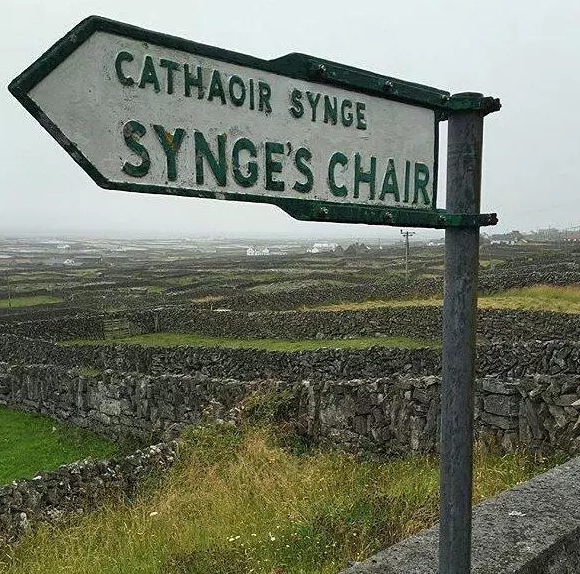
Inis Oirr (Inisheer) Island
The smallest of the islands, Inis Oirr is a traditional Irish fishing island with stunning sandy beaches. Less than 2 miles long and wide, the island is easily walkable, and you can explore its valleys and sights by foot or by bicycle.
The island may be small but it has a fascinating history and like the other islands is dotted with ancient ruins including a buried church that lies six feet below the surface
Cycling the roads lined with stone walls and dotted with wildflowers is the best way to explore Inis Oirr. The smallest of the Aran Islands and the closest to the mainland, Inis Oirr has a similar terrain to The Burren in County Clare, and therefore, its flora is under preservation.
The first thing you’ll notice about the island is the powder-soft, white sandy beach lapped by crystal clear waters. It’s a wonderful opening to the islands that blends moments of fragile beauty with the rough and solid limestone typical of the area.
Places to Stay on Inis Oirr
Here’s some recommended accommodation options when staying on Inis Oirr:
- An Creagn B&B - Comfortable rooms with great views in this modern and clean B & B.
- Inisheer Hotel - Clean and friendly hotel on the beach with a popular bar.
- Tigh Ruairi - A friendly pub with a cosy B&B attached.
Things to See and Do on Inis Oirr
- The Plassy - A shipwreck that ran aground on the island after a storm in March 1960. A nearby pub, Tigh Ned, displays photographs and documents detailing the rescue of the people onboard, all of whom miraculously survived.
- O’Brien’s Castle - A ruined castle dating back to 1585, that was built on the highest point on the island. After climbing the 100m to the top you’ll be rewarded with stunning views that are particularly spectacular at sunset.
- St Kevin’s Church - The ruins of the 10th century St. Kevin’s church are below the surface of the earth, as sand has blown over the site and covered it up over hundreds of hears. However, it’s been uncovered so you can climb down
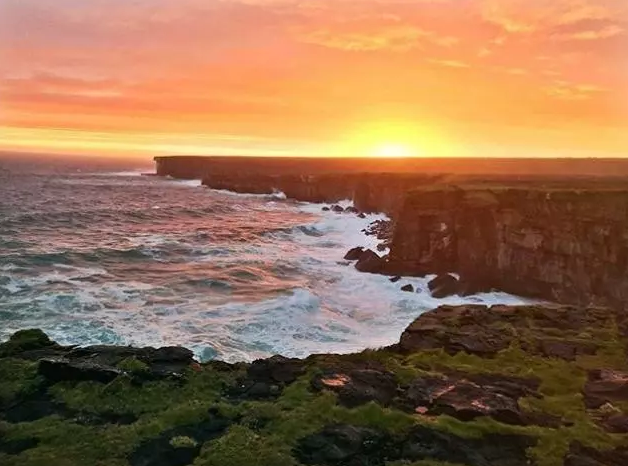
Popular Activities on the Aran Islands
Apart from the main tourist attractions on each island, the Aran Islands offer a wide range of activities for solo travelers, couples, and families alike.
Surfing
The swells generated in Galway bay make the islands a popular spot for surfers
Hiking
The islands are relatively flat, making some walks accessible to all fitness levels, with stunning scenery.
A popular walk is The Ring of Aran on Inis Mor starting at Kilronan village, visiting the standing stones, Kilmurvey beach, the seal colony, Dún Aonghasa, the Wormhole, and the lighthouse.
The walk takes around 3-6 hours and you’ll be rewarded with panoramic views as well as seeing many sights on the island.
Fishing and Boating
Fishing is part of traditional life on the Aran Islands and is also a popular yachting locating, particularly in the summer months.
Cycling
Due to the small number of motorized vehicles on the island and the flat geography, cycling is the most popular method of transport for visitors.
The 30-minute bike ride from the Pier on Inis Mr Island to Dún Aonghasa is regarded as one of the most popular cycling routes in Ireland.
Yoga and Meditation
There are a few parts of the world where you can relax and focus in absolute silence, but the Aran Islands is one of them. There are regularly arranged meditation retreats and you can, of course, enjoy your own practice there’s certainly plenty of space to find solitude.
There is a natural spiritual energy on the islands that has to be experienced to be understood. The Aran Islands have been a place of pilgrimage for thousands of years, and you can visit these sacred pilgrimage locations all over the islands.
Beaches
All three of the islands boast white sandy beaches with turquoise water that rivals the Caribbean islands.
They may be a little cooler, but if you’re lucky you can get the whole beach to yourself!
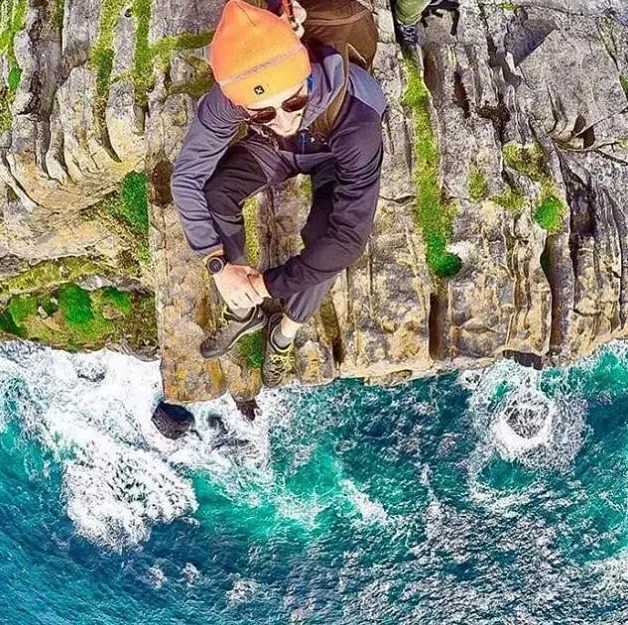
Wildlife
The Aran Islands are home to a wide array of wildlife with habitats unspoiled by human habitation and modern progress.
You can see many different types of seabirds, seals, lizards, over 400 species of wildflowers, and butterflies.
TedFest
Are you a fan of the cult TV series Father Ted? The Aran islands are the original Craggy Island and Inis Orr is pictured in the opening sequence.
The annual father ted festival Tedfest (not to be confused with a TEDx event of the same name) is held annually on Inis Mor.
Weddings and Honeymoons
In recent years, the Aran Islands have become a popular place for romantic trips due to their secluded location and moving scenery.
Some of the hotels offer wedding packages and you can even have a traditional Celtic wedding ceremony with hand fasting or blessing as the holy well.
How to Get to The Aran Islands
Aran Island Ferries sail from Rossaveal Ferry Terminal to all the islands year-round several times a day, and the crossing takes around 40 minutes. You can reach the ferry terminal by shuttle bus from Galway. Ferry crossings may be canceled in rough weather.
Doolin Ferries and O'Brien Line also run ferries in the busier season from March to November from Doolin, County Clare
If you prefer to arrive by air, Aer Arann Islands flies to all the islands from Connemara Regional Airport. The flights take only around 10 minutes and you get the bonus of seeing the spectacular scenery from above.
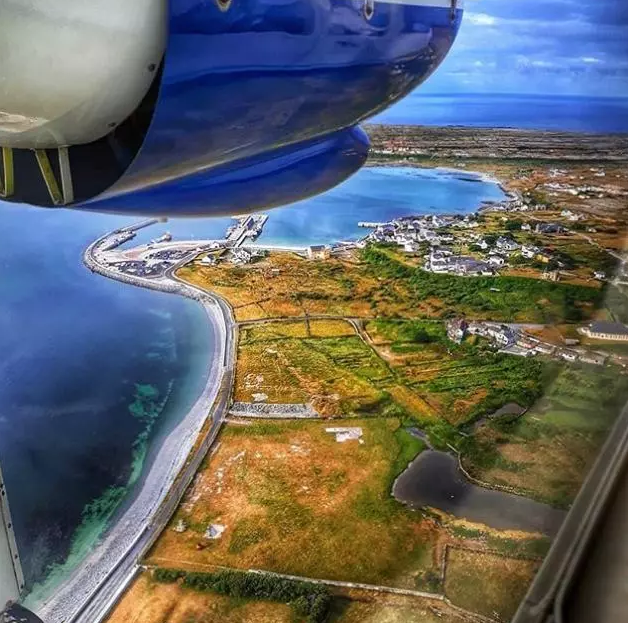
The History of the Aran Islands
The three Aran Islands are fascinating historically and culturally. Since they are such remote islands, in the past few hundred years, they have developed a very rich civilization and lifestyle that is unique to themselves.
The islands’ isolation allowed Irish culture to survive when it had already been put under so much pressure from foreign influence. Irish is still the native tongue on the islands, and the traditional Aran dress has only recently ceased to be casually worn.
The Islands have been a major part of many young Irish peoples’ lives. Many young people are sent there to learn Gaelic during the school holidays. For example, playwright John Millington Synge learnt his Irish here and wrote about the islands’ people in the play Riders to the Sea. Moreover, generations of families have tales of local storytellers, dancers in the bars, and the beauty of the place where they learnt the intricacies of their native language.
Nonetheless, the islands are known for their ancient historical sites. The most prevalent symbol of the islands’ history is the crisscrossing of intricate stone walls across the region. Built thousands of years ago, they create small sheltered areas from the strong wind, as well as providing an unusual and unique landscape.
Furthermore, there are the impressive Iron Age stone forts at Dun Aengus on Inis Mor and Dun Conchuiron on Inis Meain. Unfortunately, almost nothing is known about the people who built these structures, the people who once roamed and worked here are an enigmatic part of the past.
Additionally, some of the earliest monastic settlements were also founded here in the late 4th and 5th centuries. The monastic remnants still visible today date from the 8th century and are visited by people all over the world.
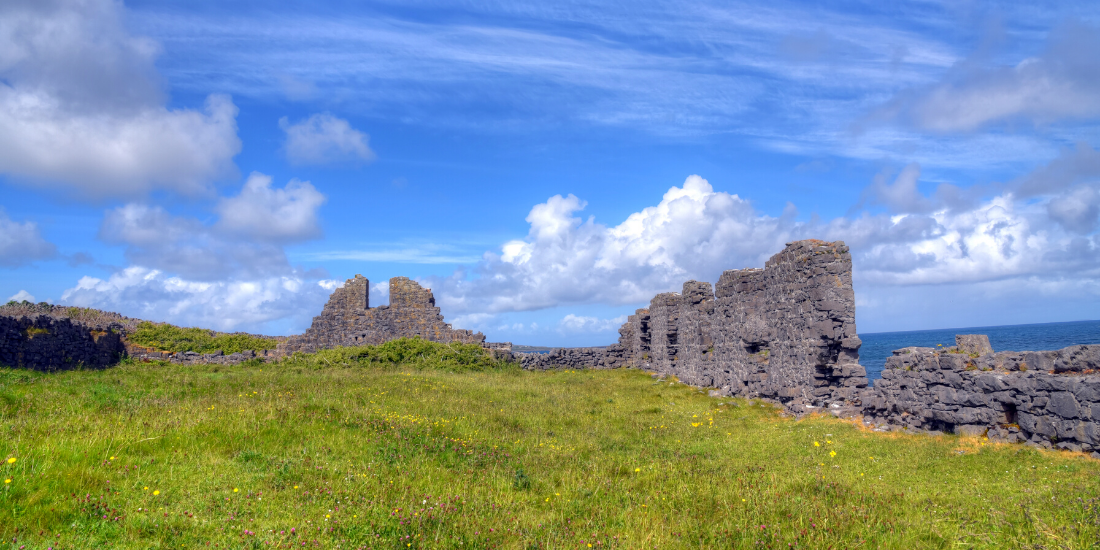
Aran sweaters are highly sought-after for their style and warmth many years after their creation. Traditionally worn out of necessity to combat the cold and tough conditions of the sea, Aran sweaters kept fishermen warm as they worked; hence the other name they’re known as, fisherman sweaters. Due to their popularity with the local fishermen, a booming new grassroots economy was born because of families making and selling them on the mainland.
As it has evolved, the modern Aran sweater is manufactured with thicker yarn, knitted flat, seams are sewn together, and the stitching is looser. This enables quick mass production. However, the Aran sweater is known and beloved for its stitching patterns and intricacies, and is considered both a practical choice and fashion statement.
An Aran sweater is a timeless staple to any cold-weather wardrobe. For more information on our Aran sweaters, please feel free to browse our men’s (think Inis Mor!), women’s (think Inis Meain!) and kids’ collections (think Inis Oirr!) and explore our authentic and high-quality collection.
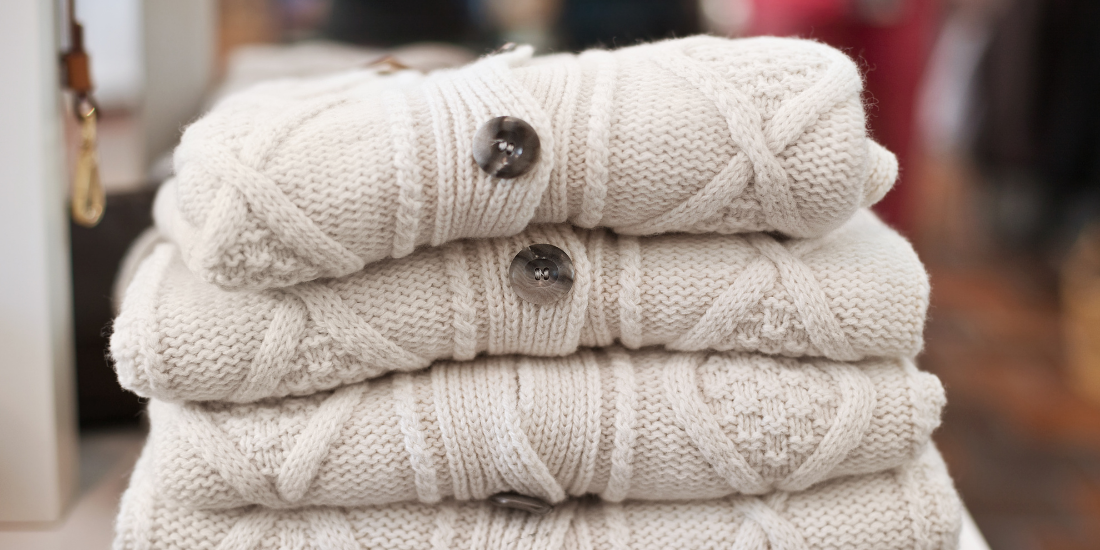
Whatever You Choose to Do in The Aran Islands – Cherish Every Moment!
We sincerely hope you’ve enjoyed this non-exhaustive list of things to enjoy and experience on your trip to the Islands of Saints and Scholars. With a wealth of culture, heritage, history and geography to fall in love with, it truly is a treasure to behold.
Be sure to pack your wet gear (and sunscreen), as the weather can be as unpredictable as the impromptu hoolies bound to break out in some of the islands’ livelier pubs! One thing’s for certain, if you love this place half as much as we do, it’s an adventure you’ll never forget!









